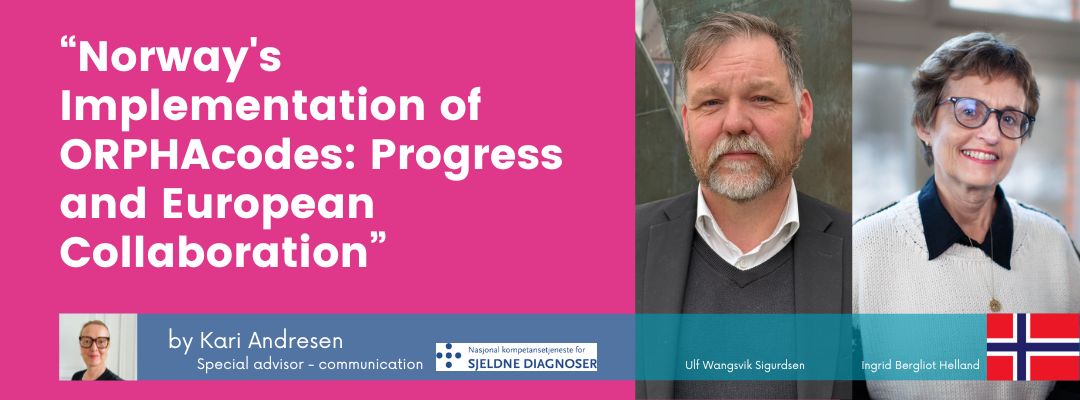Norway's Implementation of ORPHAcodes: Progress and European Collaboration
April 30th, 2025
-
- Article
- EU4Health
- JARDIN
- Norway
- ORPHAcodes

Norway’s Implementation of ORPHAcodes: Progress and European Collaboration
—by Kari Andresen
Interview with Ulf Wangsvik Sigurdsen and Ingrid Bergliot Helland on Norway’s work in rare diseases and its participation in European collaboration
Norway has made significant progress in implementing ORPHAcodes within its healthcare system in recent years. One of the four regional health authorities (Helse Nord) has successfully integrated these codes into its electronic health record system DIPS Arena, representing a key milestone in the national effort to enhance care for rare disease patients.
Ulf Wangsvik Sigurdsen, National Lead on the Joint Action project Jardin WP8 from Norway, and Ingrid Bergliot Helland, paediatrician and medical advisor at the National Advisory Unit on Rare Disorders (NSSD), share Norway’s implementation journey and how this experience contributes to broader European collaboration.
First Rollout in Northern Norway
The implementation of ORPHAcodes in Northern Norway Regional Health Authority (Helse Nord) represents the first regional health authority in Norway where the coding system is available in all hospitals through the DIPS Arena electronic health record system. This progress continues with Oslo University Hospital (OUS) and the other eight hospital trusts in the South-Eastern Norway Regional Health Authority preparing to implement ORPHAcodes in DIPS Arena within the coming months. Several private hospitals are also gaining access to the updated system this year.
– What’s important about our implementation process is that it addresses entirely new rare diseases and conditions that we can treat, as well as some new diagnoses that might be subgroups of more common diseases and promote completely different treatment approaches, Sigurdsen explains. He is a medical doctor and an economist and the manager of the e-health unit at the South-Eastern Norway Regional Health Authority.
He illustrates this point: Look at diabetes – some diabetes subgroups are rare. They require their specific treatment, and they might be mistaken for the more common diabetes types, even by health personnel. Previously, these conditions were classified under the general diabetes umbrella because we didn’t know better. Now, our medicine is more precise. And our IT systems in the health domain must be updated and comply.
Local Experience from Oslo University Hospital
Ingrid Bergliot Helland, who has been a medical advisor at NSSD since 2021 and is responsible for Norway’s contribution to Work Package 7 (WP7) in the Joint Action. She shares specific insights from Oslo University Hospital (OUS):
– ORPHAcodes have been available in the electronic health record (EHR) system at Oslo University Hospital since 2021, but as a procedural coding system. Since then, the Division of Paediatric and Adolescent Medicine (Barne- og ungdomsklinikken) has had in its Action Plan that patients with rare diagnoses should be coded with ORPHAcodes. Our experience is that this increases our awareness of rare diagnoses and helps us to be more precise in our diagnostics.
– It also means that the clinician becomes more familiar with the Orphanet and uses this database more actively to get updated and quality-assured information about rare diagnoses. ORPHAcodes are recommended to be used in the context of ERN. By using these also in Norway, cooperation with the rest of Europe becomes easier. The use of ORPHAcodes also makes it possible to find patients with specific diagnoses later, if questions arise about individual diagnoses.
Building the Norwegian Registry on Rare Disorders
A central element in Norway’s approach is the development of the Norwegian Registry on Rare Disorders, which works in tandem with the ORPHAcoding implementation.
– We are working with a registry that will eventually provide us with a national overview of the entire population with rare diseases, explains Sigurdsen. – This helps rare disease patients emerge from invisibility. Today, many patients face a situation where no one knows about their condition or available treatments. Our registry is one of the steps towards ensuring these patients receive proper diagnoses and effective treatment options.
The registry addresses a fundamental challenge with rare diseases: the fact that many healthcare professionals rarely encounter them in regular practice makes systematic coding and information access vital. While each rare disease is seldom encountered, rare diseases collectively are surprisingly common.
– Rare disease information needs to easily accessible for reference each time. If you work within orthopedics’, you know about fractures since you encounter them every week. But when you get a patient with a rare condition like haemophilia, you need to look it up every time since it might be years between each encountered case, Sigurdsen notes.
Norway’s Contribution to European Collaboration
As National Lead on the Joint Action project JARDIN WP8, Sigurdsen is key in sharing Norway’s implementation experiences with European partners.
– Through our early implementation of ORPHAcodes, Norway has gained valuable experience that we actively share with our European partners, says Sigurdsen. – The solutions we’ve developed have proven effective.
Knowledge exchange now ensures that best practices spread efficiently across European healthcare systems. By working together and sharing solutions, we can progress much faster than individual countries could.
– The challenges we face with rare diseases don’t stop at national borders, says Sigurdsen. On the contrary, aggregating rare disease patients across Europe provides a clinical and academic situation that more closely resembles that of common diagnoses, when it comes to discussing cases and conditions for research on available treatments and treatment comparisons.
Digital Integration and Future Plans
Norway is now focusing on integrating ORPHAcodes into its broader digital health infrastructure.
– We are simultaneously working on several essential elements: the technical implementation in health record systems, the development of a National registry, and integration with European collaboration platforms and quality models, summarises Sigurdsen.
Key components of this digital integration include:
- Implementation of ORPHAcodes in the two types of electronic health record systems across Norway’s regional health authorities: DIPS and EPIC
- The Norwegian Directorate of Health’s model for patient summaries in the national e-health solutions, where ORPHAcodes are now being incorporated into national information models
- Integration with the updated Clinical Patient Management System (CPMS), which will enable the exchange of de-identified patient information across European borders
- Further development of the web portal Sjelden.no, with an open information database of approximately 1,300 rare diseases registered in Norway for professional users
Sigurdsen emphasises the practical focus of these developments: – The central question is how the different ICT-solutions are designed and share data as useful support in everyday clinical practice and in clinical research on rare disease patients.
How can we ensure that technology facilitates the provision of quality care for patients with rare diseases? How is health research supported in finding new and better treatments for this underrepresented patient group? These are the practical challenges we are now working to solve.
These questions are beeing addressed through specific use cases and workshops as Norway continues to build on its implementation experience – knowledge that will benefit the broader European effort to improve care for patients with rare diseases, says Sigurdsen.
 CONTACT
CONTACT












